Artificial Intelligence: Challenges and Threats for Russia
(votes: 2, rating: 5) |
(2 votes) |
PhD, Director of the Science and Coordination Council, Moscow Institute of Physics and Technology
Discussions about artificial intelligence (AI) are in full swing and even appear on TV and in glossy magazines. But this has happened more than once in the past, and every time the interest in and enthusiasm for AI technologies has always given way to a feeling of disappointment. Who is to say that the hopes for technology will not peter out this time as well?
This article defends the thesis that the time of AI is only just beginning, and that it is AI that will close the technological packages of the new economic order. That is, strategically, AI is the most important technology today, an entrance ticket to a new digital future, as it were.
The main threat to modern Russia is that it will be relegated to the status of an outsider country in the AI race, supplementing the export of crude oil with that of raw data and leaving the advanced technological processes and added value to more developed economies.
Accordingly, Russia must make extraordinary efforts to develop the relevant competencies so as not to miss its chance to take its place among the world’s technological leaders.
Does Russia Need Artificial Intelligence?
Discussions about artificial intelligence (AI) are all over the place right now – even on TV and in glossy magazines. But this has happened more than once in the past, and every time the interest in and enthusiasm for AI technologies has always given way to a feeling of disappointment. Who is to say that the hopes for technology will not peter out this time as well? All the more so because the topic of AI is currently in vogue (see Fig. 1). So, how is the current situation different from what has come before?
Fig. 1: A great amount of hype and lofty expectations surround deep neural networks, the “workhorse” of modern AI. This is inevitably followed by disappointment and a gradual emergence from the productivity plateau at a pace dictated by the level of technological development. However, according to Gartner [16], the productivity plateau for deep learning will arrive soon, within the next five years.
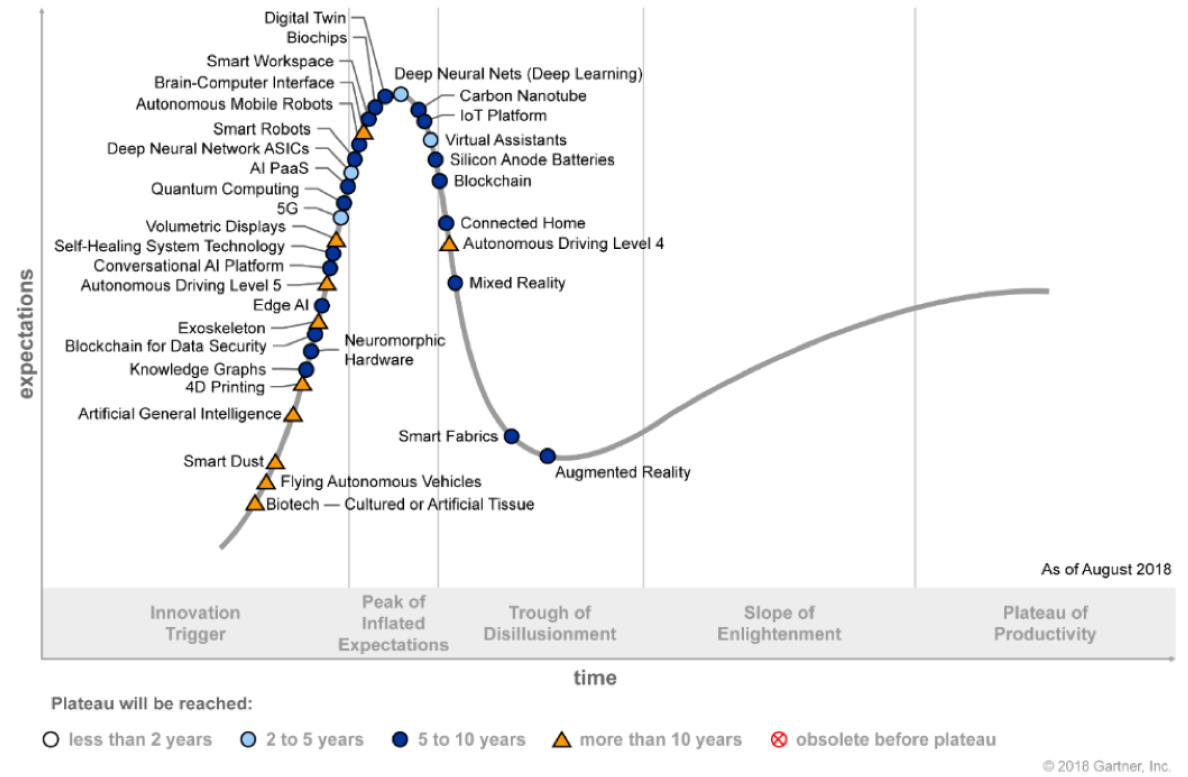
This article defends the thesis that the time of AI is only just beginning, and that it is AI that will close the technological content of the new economic order. That is, strategically, AI is the most important technology today, an entrance ticket to a new digital future, as it were. Accordingly, Russia must make extraordinary efforts to develop the relevant competencies so as not to miss its chance to take its place among the world’s technological leaders.
Overcoming the Difficulty Barrier
The development of human civilization can be viewed as a process of continuous learning, that is, the accumulation of knowledge. Indeed, what separates modern humans from their distant ancestors, early Homo sapiens? Physiologically, nothing. The only difference is in the amount of knowledge accumulated by humankind. By knowledge, we do not necessarily mean texts here, but rather operational knowledge “at the fingertips” of all human professions. This kind of knowledge is transmitted formally, in the form of research articles, technical regulations, job descriptions, etc., as well as informally, from mentor to student.
This knowledge directs people’s behaviour and drives the entire global economy. Their total volume determines the complexity of the “economic organism” and the benefit produced by the economy. The benefits for civilization cannot be measured in terms of money, but rather in terms of the goods and services available [10]. The more diverse the range of products, the greater opportunity people have to satisfy their needs and the higher the development level of the economy. In other words, economic wellbeing is directly proportional to the amount of knowledge accumulated by humankind.

Artificial Intelligence: Time of the Weak
Increased wealth means that this knowledge is growing at a faster rate than that of the human population. To be sure, Homo sapiens started to populate the Earth around 100,000 years ago with the African population numbering around 105 people. There are 1010 people on the Earth today, meaning that the population has increased by five orders of magnitude. However, the range of products has increased over that same period of time by ten orders of magnitude – from a few stone tools to 1010 (the diversity of modern UPC barcode labelling).
The amount of accumulated knowledge grows approximately in proportion to the square of the number of people who have acquired this knowledge [i]. Obviously, knowledge cannot continue to be accumulated at such a speed indefinitely. Sooner or later, the natural limitations of the human brain will be reached, which is why the aggregate volume of human memory grows in a linear fashion relative to population growth, that is, much slower.
It is my contention that this “sooner or later” has already arrived. Humankind has already faced the problem of overcoming the barrier to the complexity of the economy with its growing range of products and global division of labour.
Let us assume that all people specialize in a single “product.” In the primitive society with a minimum division of labour, everyone was engaged in the production of the same products, i.e. human knowledge was repeatedly duplicated. The economy grew as a result of the increasingly rational use of the aggregate memory of humankind – a deepening division of labour and the appearance of an increasing number of professions. It would appear that the modern world is approaching the extreme limit of the division of labour, when the repertoire of knowledge of every single specialist is unique. It is at this limit that the variety of products approaches its theoretical maximum – the number of people (see Fig. 2).
A good indicator of humankind moving towards to this limit is the change in the law of population growth [5]. Throughout all known human history, right up until the final third of the 20th century, the Earth’s population grew more or less hyperbolically: ∞ (t0–t)–1 with the point of singularity t0 ≈ 2026. [17]. This hyperbolic growth then started to slow down, and since about 2000, the relative growth rate of the population has steadily decreased. We can interpret this fact as evidence that the current technological order has exhausted its potential and is no longer able to maintain its previous growth rates. Overcoming the difficulty barrier is only possible within the framework of the new digital technological order.
Fig. 2
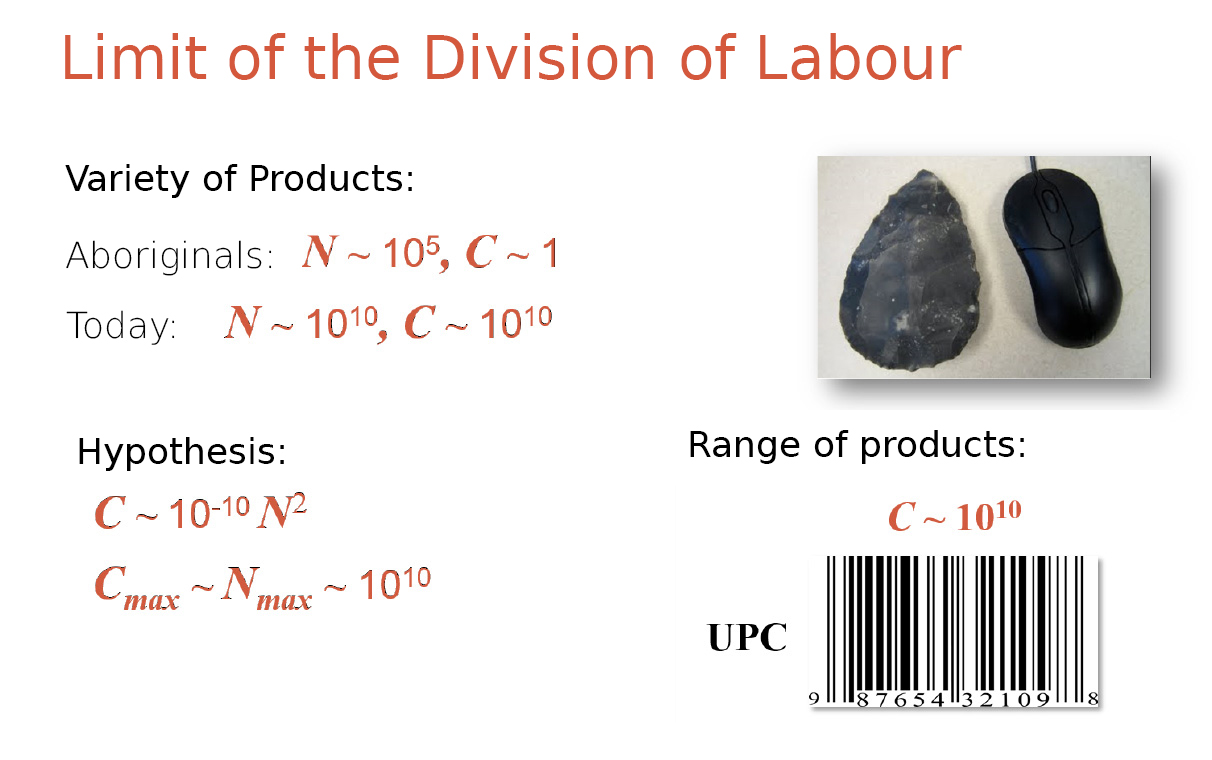
The New Technological Order
According to existing ideas, the economy develops cyclically, through technological revolutions. And it is during these technological revolutions that the technological order also changes [6], [8]. Each of these orders is characterized by the following:
- Abundant reserves of a relatively cheap base resource.
- A technological package that exploits this resource effectively.
- The organization of the market in accordance with this technological package.
The transition to a new order is only possible after a complete package of new technologies has been created. And this technological package gradually evolves to the depths of the previous order, where each cannot realize its full potential by itself. Thus, each new order begins with the creation of some kind of closing technology, the emergence of which marks the beginning of a new technological revolution. It is not hard to glean my opinion on the matter – that artificial intelligence is this closing technology.
The resource base of the outgoing industrial technological order is cheap and abundant fossil fuels – the energy base of the modern economy. The technological package is made up of machine-made technologies and global transport networks. Finally, multinational corporations provide complex value chains.
What will determine the form of the new digital technological order?
A New Abundant and Affordable Resource
The main limiting factor of the industrial order, as we suggested above, is not the depletion of energy resources, but rather the limited ability of the human brain to manage the increasingly complex global economy. “The share of direct and indirect administrative costs of every single product that we use in the early 21st century amounts to 50–80 per cent.” [2]
The response to this challenge was the emergence and rapid development of computer technologies. Computers have made it possible to transfer algorithms from the human mind to an environment where they can be executed billions of times faster. Accordingly, everything that can be formalized is transferred from the human brain to this new artificial digital environment. The seed of this new phase in the depths of the old order grows in accordance with Moore’s Law – that computing power doubles every one-and-a-half to two years, while the costs are halved. Effectively, this law also describes the emergence of new abundant and affordable resource for humankind. Sooner or later, the exponential growth of computing power will surpass the more or less constant “computing power” of people.
In a sense, this moment has already arrived, and we are living in an era in which the “canopy” of computing power that is superior to the cumulative “computing power” of people (the number of people multiplied by the maximum amount of their individual knowledge and the speed at which this knowledge can be accessed) [ii] continues to grow (See Fig. 3).
Fig. 3: Growth of cumulative computing power according to [12]. This computing power is not concentrated in general purpose processors (CPU, the lower branch), but rather in graphics accelerators (GPU, the upper branch), which are, on the whole, used to train artificial neural networks.
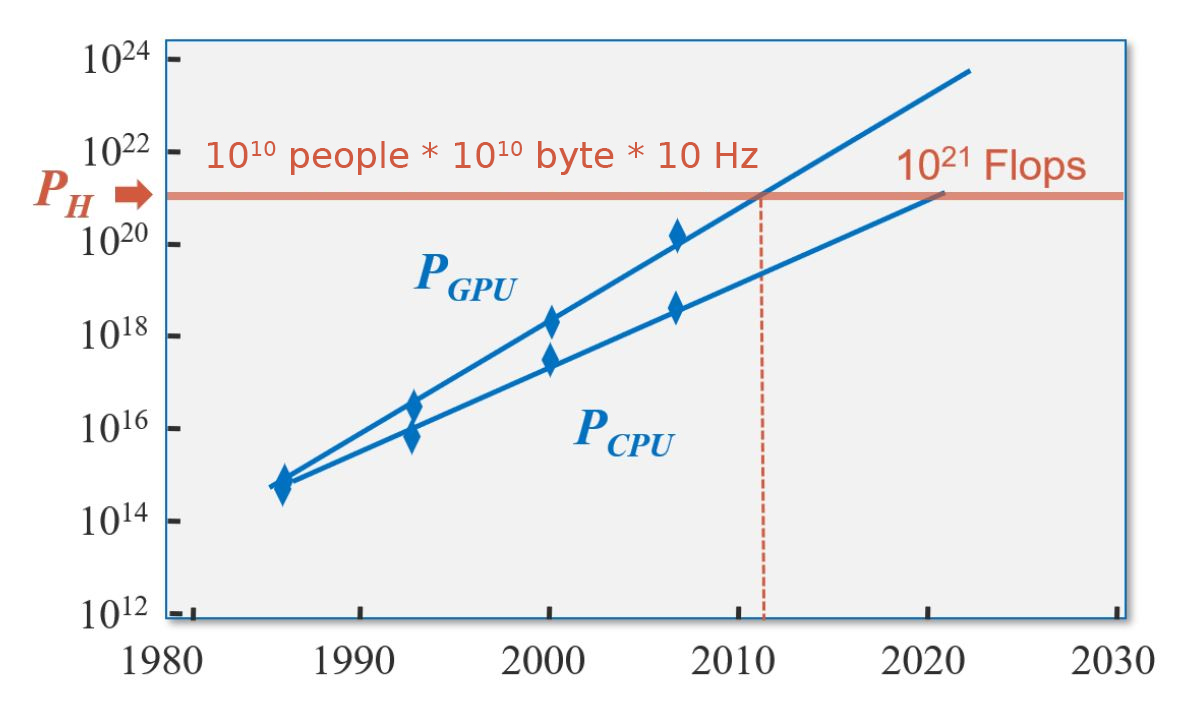
Computing power thus represents a new abundant and affordable resource for the emergence of a new digital technological order. Moreover, unlike other resources, computing power is constantly and rapidly growing and becoming more affordable. In other words, it is the main potential source of economic growth today [iii].
However, the potential contained in computers has thus far not been used to its full potential, and the machines for the most part stand idle. According to a recent report by the McKinsey Global Institute [15], the development of digital technologies in the United States over the past 30 years have been accompanied by a decrease in productivity growth rates.
It is my belief that only machine intelligence is capable of revealing the true economic potential of computers.
A New Technological Package
Why machine intelligence? What can machine intelligence add to existing computer technologies that is fundamentally new? And why are these technologies not enough to operate the growing and ever cheaper computing power effectively?
The answer lies on the surface. The cumulative volume of all computer algorithms ever created is miniscule compared to the total volume of human knowledge. To put it in everyday language, computers are “fast but stupid.” Accordingly, the majority of decisions are still made by people, with computers playing a supporting role, carrying out only those operations that have been formalized and automated. As a result, despite all the investments into informational technology, their influence on the economy is extremely limited.
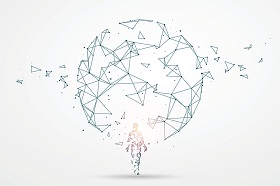
AI Nationalism and AI Nationalization Are ahead
The process of formalizing human knowledge is extremely slow, as algorithms are created by a small layer of the population – programmers (there are roughly 107 programmers in the world today). The amount of knowledge in computer programs is limited by the cumulative knowledge of programmers, which is three orders of magnitude lower than the total amount of human knowledge.
If algorithms continue to be created by humans, then, given the speed at which knowledge is updated, this process could drag on forever. The only way out of this situation is to do away with the bottleneck that is “manual” programming and delegate the creation of computer programs to computers themselves. This process of automatically generating algorithms is provided by machine learning.
Thus, only machine learning, supported by the current level of computing power, is able, in a short amount of time, to dramatically increase machine intelligence to the level of humans and charge this computing power with tasks that only humans are able to perform at the present time.
This is precisely what we have seen over the past few years, after so-called deep learning became the main paradigm of AI [13]. This approach has been successfully harnessed in the recent developments in computer vision, voice recognition, machine translation, etc., where highly specialized machine intelligence has reached the level of human intelligence and is thus is capable of partially replacing it.
In other words, artificial intelligence is the closing technology of the new technological package that is a necessary and sufficient condition for a new industrial revolution to begin.
A New Market Organization
In every order, the basic “cells” of the “economic organism” can be identified [8]. The first industrial revolution gave rise to factories, while the second spawned transnational corporations. What will be the main method of market organization in the new digital order? How will AI technologies fit into this?
The basis of the industrial order is the mass production and distribution of goods. Manufacturers fill the market with goods, focusing on mass demand. Any non-standard demand remains unsatisfied.
In the digital world, markets are customized to individual needs. The ability to meet any demand multiplies the market volume due to the long tail effect [7]. This applies to the labour market as well: just like a given product finds a buyer, a given ability, skill or piece of knowledge find their application within temporary project teams with unique combinations of unique competencies. Transferring part of the work to intelligent agents with superhuman abilities can help productivity grow many times over.
Digital platforms operating digital counterparts for goods, services and people will be able to matchmake supply and demand with extreme precision. In fact, we can already see this today: companies of the new economy provide exclusively personalized services – Google and Facebook provided individual delivery of information and advertising, while Amazon and Netflix help select products and entertaining that the customer will like, guessing the needs of users on the basis of their digital footprints.
These new companies-cum-platforms are actively pushing transnational corporations of the past order aside, and they are growing at a rate that far outstrips that of the global economy (see figs. 4 and 5).
Fig. 4: The biggest companies in the world are becoming the leaders of the new digital order.
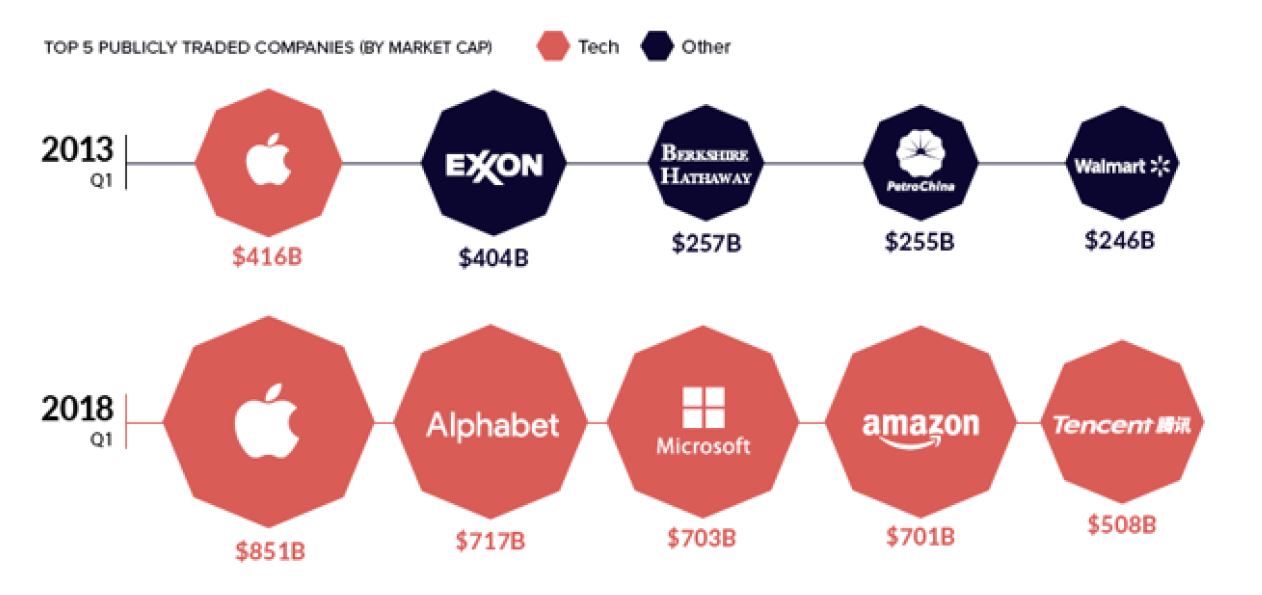
Fig. 5: The leaders of the new order are growing rapidly. Their average growth rate (20–60%) is several times greater than that of the global economy (2.5–3%).

This can be explained by the positive feedback effect that is characteristic of the new economy and which is based on machine learning: more customers – more data – higher quality service – even more customers. After all, the results of machine learning are proportional to the volume of data. This is why companies of the new economy that were the first to seize a segment of the market quickly pull away from the rest of the pack.
The Race for Artificial Intelligence
An understanding of the role that leadership plays in the economy of the new order has given rise to a new technological race – the race for artificial intelligence. Over the past couple of years, several dozen countries have developed their own national strategies for artificial intelligence [9].
Even though it has only just begun, the new race is no less intense than the nuclear and space races of the 20th century in terms of the scale of investments, which continue to grow by over 10 per cent every year. The leaders in this race are the ones who started it – the United States and China – and they are well out in front (see Fig. 6).
Fig. 6: Investments in the main technological races – the nuclear race, the space race and the AI race. The data on the Manhattan Project and the Apollo program is taken from Wikipedia, with the relevant figures for 2016 being converted into dollars. AI figures for 2016 are estimates [11].

The participants in the AI race are in a rush to join the global value chains of the growing new economy, with far greater labour productivity [iv].
The remaining countries will fall further and further behind the leaders in terms of the quality of life and life expectancy and could risk becoming failed states. Their sovereignty will be largely illusory in nature, as all major economic decisions will be made without their participation and without regard for their interests.
From this perspective, the main threat to modern Russia is that it will be relegated to the status of an outsider country in the AI race, supplementing the export of crude oil with that of raw data and leaving the advanced technological processes and added value to more developed economies.
The Challenges for Russia
Today, Russia has a rare window of opportunity to take part in the development of a new economy on more or less on an equal footing and stake its claim to certain sectors of the rapidly growing new markets while the leaders in the AI race have not yet pulled too far ahead.
Of course, the United States has a significant lead here, but this does not mean that it is destined to win this new race. A wonderful book published recently [14] provides grounds to believe that China could catch up with and even overtake the United States in this race. China’s strategy is based on its natural competitive advantages – the fact that it is a leader in model payments and e-commers, the abundance of data generated in the country, and the highly competitive environment for small and medium-sized businesses.
Russia should also base its strategy on its competitive advantages, for example, on its traditionally strong schools of physics, mathematics and computer programming. These are real advantages today, as value creation centres are moving away from production and towards development and design [v], and the intelligence of developers becomes the main production force in the economy [4].
Russia is a supplier of these highly qualified specialists yet receives practically nothing in return. The only way that the country could get an economic return from these experts is if there were major domestic companies that had staked their claim to certain sectors of the new economy. These companies – world-class competence centres – will generate an actual demand for the best Russian professionals and invest in them at home. They will be the ones buying up successful venture projects to accelerate their own growth, thus providing domestic demand for the Russian venture industry.
I believe that the Russian strategy should involve creating several dozen hi-tech companies each with a turnover of tens of billions of dollars and forming part of the global elite as recognized by the Forbes Global 2000 list. Based on Russia’s current share of the gross world product, Russian companies should make up no less than 2 per cent of the list, or over 40 companies (there are only 25 Russian companies in the list today) [vi].
The National Technological Initiative was set up to help Russian companies enter new global markets. The window of opportunity has not yet closed with regard to the next 10–15 years. During this time, the National Technological Initiative and the Russian government need to ensure that at least 15 Russian digital “unicorns” of a similar size to Sistema and United Aircraft Corporation (currently the only Russian hi-tech companies in the Forbes Global 2000 list) are present on and have a foothold in new markets.
This is a real challenge for Russia. However, I believe that the country’s strategy for the development of the digital economy should be directed towards achieving results in this area. And this will truly require extraordinary efforts on the part of the Russian people.
Bibliography
1. A. V. Korotaev, S. Y. Milkov and L. E. Grinina. Analysing and Modelling Global Dynamics. Lenand, 2018.
2. D. A. Kovalevich and P. G. Shchedrovitsky. Conveyor of Innovations, https://asi.ru/conveyor-of-innovations/, 2015.
3. V. Zavidovskaya and K. Karpov. Company Ranking by Employee Productivity. https://bcs-express.ru/novosti-i-analitika/reiting-kompanii-po-proizvoditel-nosti-truda-sotrudnikov, 2017.
4. I. R. Agamirzyan. Technological Leadership: Taking One’s Chance. Challenge 2035, pp. 8–15. Olimp-Business, 2016.
5. S. P. Kapitsa. General Theory of the Growth of Humankind: How Many People Have Lived and Will Live on the Earth? Moscow: Nauka, 1999.
6. Carlota Perez. Revolutions and Financial Capital. Delo, 2011.
7. Chris Anderson. The Long Tail: Why the Future of Business is Selling Less of More. Mann, Ivanov & Ferber, 2012.
8. P. G. Shchedrovsky. The History of Industrial Revolutions and the Challenges of the Third Industrial Revolution. https://voutu.be/_cpWkGwZMSI, 2016.
9. S. V. Karelov. Onward. AI Nationalism and AI Nationalization. http://russiancouncil.ru/activity/digest/longreads/vperedi-ii-natsionalizm-i-ii-natsionalizatsiva/, 2018.
10. Eric D. Beinhoeker, The Origin of Wealth: Evolution, Comple
xity, and the Radical Remaking of Economics. Harvard Business Press, 2006.
11. Jacques Bughin, E. Hazan, S. Ramaswamy, M. Chui, T. Allas, P. Dahlstrom, N. Henke, and M. Trench. Artificial Intelligence – The Next Digital Frontier. McKinsey Global Institute. URL https://www.mckinsey.de/files/170620_studie_ai.pdf, 2017.
12. M. Hilbert and P. Lopez. The World’s Technological Capacity to Store, Communicate, and Compute Information. Science (New York, NY), 332(6025):60–65, 2011.
13. Yann LeCun, Yoshua Bengio, and Geoffrey Hinton. Deep Learning. Nature, 521 (7553):436–444, 2015.
14. Kai-Fu Lee. AI Superpowers: China, Silicon Valley, and the New World Order. Houghton Mifflin, 2018.
15. James Manyika, Jaana Remes, Jan Mischke, and Mekala Krishnan. The Productivity Puzzle: A Closer Look at the United States. McKinsey Global Institute, 2017.
16. К. Panetta. 5 Trends Emerge in the Gartner Hype Cycle for Emerging Technologies, 2018. https://www.gartner.com/smarterwithgartner/5-trends-emerge-in-gartner-hype-eyele-for-emerging-teehnologies-2018/, 2018.
17. Heinz Von Foerster, Patricia M. Mora, and Lawrence W. Amiot. Doomsday: Friday, 13 November, ad 2026. Science, 132(3436):1291–1295, 1960.
i. Gross world product (GWP) is also proportional to the square of the number of people [1]. That is, it does indeed grow in proportion to the amount of knowledge.
i. The limit of individual knowledge is determined by the speed of human learning (the speed of speech is 10 bytes per second). A human being who studies for 12 hours a day over the course of 60 years can assimilate a maximum of 1010 bytes. Accordingly, the limit of knowledge in the heads of all humankind is 1020 bytes. The maximum “computing power” of humankind (1021 bytes per second) can be achieved by multiplying this value by the “clock speed” of the human brain, which is ~ 10 Hz.
i. Of course, computing power is not a natural resource. Rather, it a technological resource. But technological packages consist of stacks of different technologies, with the lower floors serving as a resource for the upper floors. We stooped at the rather well developed mass production of computer chips, otherwise we would have to consider silicon or even sand as the main resource of the digital economy.
i. For example, Apple’s revenue per employee is about $2.2 million, which is seven times higher than Rosneft and 70 times higher than Rostelecom [3].
i. Product design, engineering and branding make up 89 per cent of Apple’s production costs, while component production and assembly account for just 11 per cent [4].
i. There were 29 Russian companies in the list 10 years ago, and this number will decrease steadily as companies of the outgoing order will be gradually pushed out.
(votes: 2, rating: 5) |
(2 votes) |
The country's leadership is trying to heed the lessons of the past so as not to miss the historic chance of leading the digital revolution
AI Nationalism and AI Nationalization Are ahead“Artificial Intelligence” (AI) as the key factor in economic, geopolitical and military power of the coming decades
Artificial Intelligence: Time of the WeakCurrent Status, International Trends, Myths and Prospects of AI Application
RAI. Remotely Accessible IntelligenceRemotely Accessible Intelligence: The Near Future for Our World





